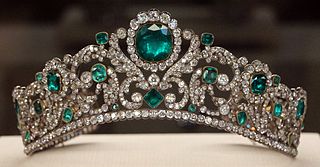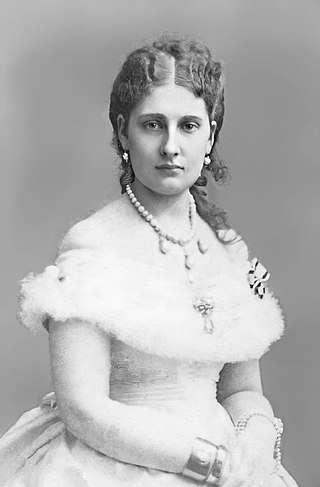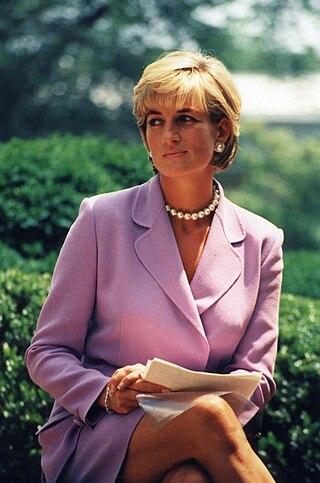
Crown jewels are the objects of metalwork and jewellery in the regalia of a current or former monarchy. They are often used for the coronation of a monarch and a few other ceremonial occasions. A monarch may often be shown wearing them in portraits, as they symbolize the power and continuity of the monarchy. Additions to them may be made, but, since medieval times, the existing items have been typically passed down unchanged, symbolizing the continuity of a monarchy.

A tiara is a jeweled head ornament. Its origins date back to ancient Iran, which was then adapted by Greco-Romans. In the late 18th century, the tiara came into fashion in Europe as a prestigious piece of jewelry to be worn by women at formal occasions. The basic shape of the modern tiara is a semi-circle, usually made of silver, gold or platinum and richly decorated with precious stones, pearls or cameos.

Victoria Eugenie of Battenberg was Queen of Spain as the wife of King Alfonso XIII from their marriage on 31 May 1906 until 14 April 1931, when the Spanish Second Republic was proclaimed. A Hessian princess by birth, she was a member of the Battenberg family, a morganatic branch of the House of Hesse-Darmstadt. She was the youngest granddaughter of Queen Victoria and Prince Albert. Unlike other members of the Battenberg family, who were accorded the lower rank of Serene Highness, Victoria Eugenie was born with the rank of Highness due to a Royal Warrant issued in 1886 by Queen Victoria.

A parure is a set of various items of matching jewelry, which rose to popularity in early 19th-century Europe.

Infanta Maria Ana of Portugal was a Portuguese infanta (princess), the eldest surviving daughter of Queen Maria II of Portugal and her King consort, Ferdinand II of Portugal, a member of the House of Braganza.

Infanta Antónia of Portugal was a Portuguese infanta (princess) of the House of Braganza, daughter of Queen Maria II of Portugal and her King consort Ferdinand II of Portugal. Through her father, she also held the titles of Princess of Saxe-Coburg and Gotha and Duchess of Saxony.

Garrard & Co. Limited designs and manufactures luxury jewellery and silver. George Wickes founded Garrard in London in 1735 and the brand is headquartered at Albemarle Street in Mayfair, London. Garrard also has a presence in a number of other locations globally. Garrard was the first official and most notably important Crown Jeweller of the United Kingdom having supplied jewels for Queen Victoria, and was charged with the upkeep of the British Crown Jewels, from 1843 to 2007, and was responsible for the creation of many tiaras and jewels still worn by the British royal family today. As well as jewellery, Garrard is known for having created some of the world's most illustrious sporting trophies, including the America's Cup, the ICC Cricket World Cup Trophy and a number of trophies for Royal Ascot in its role as Official Trophies and Silverware Supplier, which originally dates back to the first Gold Cup in 1842.

Infanta María de la Paz of Spain was a Spanish infanta. A daughter of Queen Isabella II, she married her cousin Prince Ludwig Ferdinand of Bavaria. She lived the rest of her life in Germany, dedicating her time to her family, charity work and writing poetry. She wrote a book of memoirs: Through Four Revolutions: 1862–1933.

Marie-Étienne Nitot was a French jeweller, the official jeweller to the Emperor Napoleon, and the founder of the House of Chaumet.

Queen Elizabeth II owned a historic collection of jewels – some as monarch and others as a private individual. They are separate from the gems and jewels of the Royal Collection, and from the coronation and state regalia that make up the Crown Jewels.

The Pantheon of the House of Braganza, also known as the Pantheon of the Braganzas, is the final resting place for many of the members of the House of Braganza, located in the Monastery of São Vicente de Fora in the Alfama district of Lisbon, Portugal. The pantheon's burials have included Portuguese monarchs, Brazilian monarchs, a Romanian monarch, queen consorts of Portugal, and notable Infantes of Portugal, among others.

The Portuguese crown jewels, also known as the Royal Treasure, are the pieces of jewelry, regalia, and vestments that were used by the Kings and Queens of Portugal during the time of the Portuguese Monarchy. Over the nine centuries of Portuguese history, the Portuguese crown jewels have lost and gained many pieces. Most of the current set of the Portuguese crown jewels are from the reigns of King João VI and King Luís I.

The Diadem of the Stars is a Diamond Tiara originally commissioned by Queen Consort Maria Pia of Savoy, who had a love for jewellery and fashion. It is a piece of the Portuguese Crown Jewels.
Mellerio dits Meller is a French jewellery house, founded in 1613, and still active today. It is the oldest family company in Europe. It gives its name to the Mellerio cut, a 57-facet jewel cut, shaped as an oval within an ellipse. Today Mellerio is based in rue de la Paix, Paris, with branches in Luxembourg and Japan. It is a member of the Comité Colbert and also of the Henokiens, an international club made up of family companies over 200 years old. Directors François and Olivier Mellerio are the fourteenth generation to run the family business.

Crown Jewels of the Netherlands is the jewellery used by the Dutch royal family, which is sometimes dubbed "crown jewels". In the past, the terms "House-diamonds", "House-jewels" and "family jewels" have been used. In 1790 the term "Bijoux de la Couronne" was used by Luise of Brunswick -Wolfenbüttel to refer to a large diamond from Borneo. In 1896 the Firm of van Kempen & Begeer wrote about resetting the jewels of the Crown. Queen Juliana gave a selection of her formal jewelry to the new Foundation Regalia of the House of Orange-Nassau, instituted on 27 July 1963. In 1968 a Foundation "Kroongoederen van het Huis van Oranje-Nassau" was instituted. It owns the regalia and the House-jewels.

Diana, Princess of Wales, owned a collection of jewels both as a member of the British royal family and as a private individual. These were separate from the coronation and state regalia of the crown jewels. Most of her jewels were either presents from foreign royalty, on loan from Queen Elizabeth II, wedding presents, purchased by Diana herself, or heirlooms belonging to the Spencer family.

The Queen Marie of Romania Sapphire is a 478.68 carat Cornflower blue cushion cut Ceylon sapphire. When it was sold at Christie's in 2003, it was the largest sapphire ever offered at auction. It is named for its association with its first owner, Marie of Edinburgh, Queen of Romania.
The joyas de pasar are a historic collection of jewels, privately owned by the head of the Spanish royal family, to be worn by the Queen of Spain on solemn occasions. The initial jewellery set was gathered by Queen Victoria Eugenie, wife of King Alfonso XIII, and are transmitted to the next generation following the instructions that she left in her will. They are separate from the Regalia of Spain which is owned by the Spanish State.
Maria Francisca of Braganza, is the second child and only daughter of the pretender to the defunct Portuguese throne Duarte Pio, Duke of Braganza and Isabel de Herédia. She is a claimant to the courtesy titles of Infanta of Portugal and Duchess of Coimbra.


















